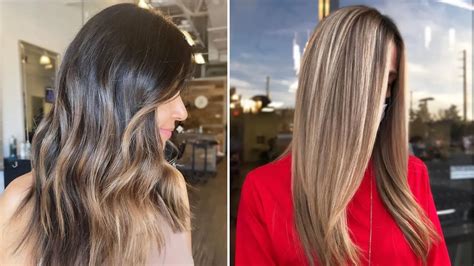When embarking on a hair color transformation, understanding the distinction between highlights and balayage becomes imperative. Both techniques enhance hair with lighter hues, yet they employ different approaches, creating unique aesthetics. Here’s a comprehensive breakdown to guide your decision-making:

Application Techniques
Highlights:
- Utilizes foils or caps to isolate sections of hair.
- The isolated strands are then lifted or lightened using bleach or color.
- This targeted application results in precise, striped highlights.
Balayage:
- Involves freehand painting lightener or color onto the hair’s surface.
- The stylist sweeps the brush in a diagonal motion, creating a more natural, blended effect.
- No foils or caps are used, allowing for greater flexibility and customization.
Color Patterns
Highlights:
- Creates distinct, contrasting streaks of color.
- The thickness and placement of the highlights are customizable, allowing for a variety of looks.
- Can result in a more dramatic color change.
Balayage:
- Blends lighter hues into the natural hair color, resulting in a subtle, sun-kissed effect.
- The color transition is more gradual and seamless.
- Aims to mimic the natural lightening that occurs from sun exposure.
Maintenance
Highlights:
- Require regular touch-ups every 4-8 weeks to maintain brightness and prevent root regrowth.
- The precise placement of highlights can make roots more noticeable.
- May require more frequent salon visits and professional hair care products to prolong longevity.
Balayage:
- Generally requires less frequent touch-ups (every 8-12 weeks).
- The blended, sun-kissed effect helps conceal root regrowth, reducing the need for immediate touch-ups.
- Can be more cost-effective due to less frequent salon appointments.
Suitability
Highlights:
- Ideal for creating bold, structured looks with contrasting colors.
- Suitable for those who desire a more dramatic hair transformation.
- Can accentuate facial features and enhance hairstyles.
Balayage:
- Best for achieving natural-looking, sun-kissed hair with a seamless blend.
- Suitable for all hair types and complexions, providing a versatile styling option.
- Can add dimension and movement to hair, creating an effortless, lived-in look.
Price Comparison
The cost of both highlights and balayage varies depending on the length of hair, the desired result, and the pricing structure of the salon. On average, highlights typically cost more than balayage due to the more labor-intensive application process.
Pros and Cons of Each Technique
Table 1: Highlights
| Feature | Pros | Cons |
|---|---|---|
| Precision | Creates sharp streaks of color | Can look unnatural if not blended well |
| Flexibility | Allows for customization of placement and width | Requires frequent touch-ups and root maintenance |
| Bold Look | Enhances facial features and hairstyles | Can be high-maintenance and expensive |
Table 2: Balayage
| Feature | Pros | Cons |
|---|---|---|
| Natural Blend | Mimics the effects of sun exposure | Can be subtle and may not be noticeable on darker hair |
| Low-Maintenance | Requires less frequent touch-ups | May not provide as dramatic a color change as highlights |
| Versatile Styling | Adds dimension and movement to hair | Can be more difficult to achieve on shorter hair lengths |
Benefits of Both Techniques
- Enhances overall hair color and texture.
- Creates a more polished and professional appearance.
- Boosts confidence and self-esteem.
- Can conceal gray hairs and root regrowth.
- Offers a wide range of customization options to suit individual preferences.
Factors to Consider Before Choosing
- Desired Look: Highlights offer bold streaks, while balayage creates blended, natural-looking highlights.
- Maintenance: Highlights require more frequent touch-ups, whereas balayage is low-maintenance.
- Hair Type: Highlights are suitable for all hair types, while balayage may not be as effective on shorter hair.
- Skill of Stylist: Both techniques require a skilled stylist to achieve optimal results.
Commonly Asked Questions
-
What is the difference between partial and full highlights?
– Partial highlights only cover a portion of the hair, while full highlights cover the entire head. -
Can I do highlights or balayage at home?
– While home coloring kits are available, it is generally recommended to seek professional assistance to ensure optimal results and prevent damage. -
How long do highlights or balayage last?
– Highlights typically last for 4-8 weeks, while balayage can last for 8-12 weeks or longer. -
Can I get both highlights and balayage?
– Yes, it is possible to combine the two techniques for a more customized look. -
Which technique is better for covering gray hairs?
– Both highlights and balayage can cover gray hairs effectively, but highlights may provide a bolder contrast. -
How do I choose the right color for my highlights or balayage?
– Consult with a professional stylist who can assess your hair color, skin tone, and desired outcome to recommend the most flattering hue. -
How much do highlights or balayage cost?
– The cost varies widely depending on the salon, location, hair length, and the desired result. -
How often should I get my highlights or balayage touched up?
– Highlights typically require touch-ups every 4-8 weeks, while balayage requires less frequent touch-ups.
